Unveiling the Intricacies of Army Simulation Games: A Comprehensive Analysis


History of Army Simulation Games
Army simulation games have a rich history that traces back to the early days of gaming. These games have evolved significantly over the years, offering increasingly realistic scenarios and strategic challenges to players. Key milestones and significant releases have shaped the landscape of army simulation games, showcasing the advancement in gameplay mechanics and technology.
Gameplay Mechanics
The core gameplay mechanics of army simulation games are essential to mastering the strategic elements of gameplay. Understanding these mechanics is crucial for players looking to excel in realistic battle scenarios and tactical challenges. Tips and tricks can greatly enhance the gaming experience, providing insights into how to navigate complex missions and make critical decisions.
Protagonists and Antagonists
In army simulation games, the protagonists play a vital role in driving the narrative forward. Through detailed profiles, players get a glimpse into the backgrounds and motivations of the main characters. Character development throughout the game series offers a deeper understanding of their growth and goals. Analysis of key antagonists sheds light on their impact on the storyline, delving into their motivations and actions within the game world.
Main Missions and Side Quests
Main missions hold the crux of army simulation games, offering players a structured path through the storyline. Walkthroughs and guides can be invaluable in tackling challenging missions efficiently and unlocking achievements. Side quests, though optional, add depth to the gaming experience, providing additional rewards and benefits for those willing to explore beyond the main storyline.
Vehicles and Weapons
The catalog of vehicles and weapons available in army simulation games is vast, each with unique stats and descriptions. Mastering the customization, locations, and handling of vehicles is crucial for success in missions. Understanding the weapons arsenal and their best uses can significantly impact gameplay, offering strategies for acquiring and maximizing the efficiency of different weapons.
Introduction to Army Simulation Games
Army simulation games offer a unique gaming experience that tests players' tactical skills and decision-making abilities, making them a significant and captivating topic for exploration. This article delves deep into the realm of army simulations, providing a detailed analysis of their appeal, gameplay mechanics, and industry significance. From realistic simulations to strategic challenges, army simulation games push the boundaries of traditional gaming, offering a blend of entertainment and intellectual stimulation. Whether you are a gaming enthusiast or a strategic thinker, understanding the world of army simulation games is essential in appreciating the complexities and nuances of virtual warfare.
Defining Army Simulation Games
Simulation vs. Action Games
Within the realm of gaming, the distinction between simulation and action games plays a pivotal role in shaping the experience for players. Unlike action games that focus on fast-paced gameplay and quick reflexes, simulation games prioritize realism and strategy, challenging gamers to think critically and plan strategically. The key characteristic of simulation games lies in their attention to detail and accuracy, creating a more immersive and intellectually stimulating environment for players. The unique feature of simulation games is their ability to replicate real-world scenarios, offering a virtual sandbox for gamers to explore and experiment with different strategies and outcomes.
Elements of Realism
Realism forms the cornerstone of army simulation games, enhancing the overall gaming experience by creating authentic and believable scenarios for players to navigate. The key characteristic of realism lies in its ability to evoke a sense of immersion, making gamers feel as though they are part of the battlefield, making critical decisions that impact the course of the game. The unique feature of realism in army simulation games is its attention to detail, from weapon mechanics to environmental factors, providing a holistic and true-to-life experience that challenges players to think strategically and act decisively.
Evolution of Army Simulation Genre
Historical Context
The historical context of army simulation games traces back to the roots of military strategy and warfare, drawing inspiration from real-world battles and conflicts that have shaped our understanding of combat. By immersing players in historically accurate settings and scenarios, these games offer a glimpse into the challenges and decisions faced by military leaders throughout history. The unique feature of historical context in army simulation games is its ability to blend entertainment with education, allowing gamers to learn from the past while enjoying an engaging and immersive gameplay experience.
Technological Advancements
Technological advancements have revolutionized the army simulation genre, pushing the boundaries of what is possible in virtual warfare. From enhanced graphics to sophisticated AI algorithms, these advancements have elevated the realism and complexity of army simulation games, creating a more immersive and challenging environment for players. The unique feature of technological advancements is their ability to create cutting-edge gameplay mechanics and features that keep gamers engaged and invested in the virtual battlefield, setting new standards for innovation and excellence in game development.


Gameplay Mechanics and Features
In the realm of army simulation games, the gameplay mechanics and features play a pivotal role in delivering an immersive and challenging experience to players. From strategic decision-making to resource management, these elements contribute significantly to the overall appeal and complexity of the games. One of the key aspects of gameplay mechanics is tactical decision-making, where players are tasked with planning missions and managing resources efficiently to navigate through intense battle scenarios. This not only tests their strategic acumen but also enhances their problem-solving skills and adaptability in dynamic environments.
Tactical Decision Making
Mission Planning
When it comes to mission planning in army simulation games, meticulous strategizing is essential for success on the battlefield. Players are required to analyze the objectives, evaluate risks, and allocate resources effectively to achieve victory. The intricate nature of mission planning simulates real-world military operations, where decisions have far-reaching consequences. The feature also fosters critical thinking and situational awareness, providing players with a strategic edge.
Resource Management
Resource management is another crucial element that shapes the gameplay experience in army simulation games. Balancing limited resources such as ammunition, supplies, and manpower adds a layer of realism and complexity to the gameplay. Players must make tough choices on how to allocate resources to support their missions effectively while considering the potential risks and rewards. This aspect promotes foresight, planning, and risk assessment skills among players, reinforcing the importance of strategic decision-making.
Realism and Immersion
In army simulation games, the focus on realism and immersion enriches the gaming experience by creating authentic environments and advanced AI behaviors. Authentic environments replicate actual battlefields with precision, from terrain features to weather conditions, enhancing the sense of realism for players. This attention to detail not only enhances the visual appeal of the games but also deepens players' engagement and emotional investment in the gameplay.
Authentic Environments
The authenticity of environments in army simulation games provides players with a true-to-life battlefield experience. By recreating recognizable landscapes and incorporating historical accuracy, these games offer a heightened sense of immersion. Players navigate through terrain obstacles, strategize based on the environment, and feel the intensity of battle scenarios, fostering a sense of realism and urgency in their decision-making.
Advanced AI Behavior
The advanced AI behavior in army simulation games elevates the level of challenge and unpredictability for players. AI-controlled entities exhibit adaptive and strategic behaviors, reacting realistically to player actions and altering tactics based on dynamic circumstances. This not only keeps the gameplay dynamic and engaging but also sharpens players' tactical skills as they contend with intelligent opponents. The intricate AI systems contribute to the replay value and depth of army simulation games, fostering strategic thinking and quick decision-making.
Multiplayer Dynamics
Multiplayer dynamics in army simulation games offer players the opportunity to collaborate in cooperative gameplay or compete in challenging competitive modes. These dynamics enhance social interaction, teamwork, and competitive spirit among players, adding a new dimension to the gaming experience. Whether working together towards a common goal or facing off in intense battles, multiplayer features contribute to the longevity and excitement of army simulation games.
Cooperative Gameplay
Collaborative play in army simulation games promotes teamwork, communication, and coordination among players. By engaging in cooperative missions, players learn to strategize together, leverage individual strengths, and overcome challenges collectively. The cooperative gameplay not only cultivates camaraderie and bonding but also enhances players' ability to work as a team, reinforcing essential skills in leadership and collaboration.
Competitive Modes
Competitive modes in army simulation games pit players against each other in intense, skill-based encounters that test their strategic prowess and combat abilities. Whether engaging in head-to-head battles or team-based competitions, competitive modes offer a platform for players to showcase their skills, adapt strategies on the fly, and strive for victory. The competitive nature of these modes fosters a spirit of challenge and sportsmanship among players, motivating continuous improvement and strategic innovation.
Notable Army Simulation Titles
In this article, we delve into the pivotal aspect of Notable Army Simulation Titles, which stands as a cornerstone in the realm of army simulation games. These titles hold substantial significance in shaping the gaming landscape, offering players immersive experiences that test their tactical acumen and strategic thinking. From authentic combat simulations to intricate military strategies, Notable Army Simulation Titles serve as benchmarks for the genre, setting standards for realism and complexity.
Arma Series


Realistic Combat Simulation
The Arma Series is renowned for its unparalleled focus on Realistic Combat Simulation, immersing players in lifelike combat scenarios with meticulous attention to detail. This specific aspect sets Arma apart as a pinnacle of authenticity in the gaming world. The hyper-realistic features of combat in Arma not only enhance the gameplay experience but also challenge players to adapt and strategize effectively within the context of genuine military operations. Despite its complexity, the Realistic Combat Simulation in Arma adds depth and intensity to the gameplay, setting it apart as a top choice for enthusiasts seeking a true-to-life combat experience.
Military Strategy Focus
Within the Arma Series, Military Strategy Focus plays a crucial role in elevating the overall gaming experience to one focused on strategic decision-making and tactical planning. This aspect places a spotlight on the importance of intellectual engagement and foresight in navigating the challenges presented in the game. By emphasizing military strategy, Arma encourages players to think critically, consider various approaches, and execute well-thought-out plans to achieve success. The integration of Military Strategy Focus not only enriches the gameplay but also fosters a community of players dedicated to honing their strategic capacities.
Operation Flashpoint
Open-World Gameplay
Operation Flashpoint's Open-World Gameplay aspect provides players with vast, dynamic environments to explore and conquer, offering a sense of freedom and immersion unparalleled in the gaming world. This feature allows for expansive exploration and varied approaches to missions, giving players a truly open-ended experience. Although the open-world design enhances player agency and realism, it also poses challenges in terms of maintaining coherence and narrative progression within a non-linear framework.
Authentic Weapon Handling
Authentic Weapon Handling in Operation Flashpoint ensures that players engage with firearms and equipment in a realistic manner, adding a layer of authenticity to the gameplay experience. This specific aspect not only educates players on proper weapon usage but also heightens the sense of realism and urgency during combat scenarios. However, the dedication to authentic weapon handling may present a steep learning curve for newcomers to the game, requiring patience and practice to master effectively.
Company of Heroes
WWII Setting
Company of Heroes' WWII Setting immerses players in the tumultuous era of World War II, offering a historical backdrop that adds depth and context to the gameplay experience. This specific aspect not only grounds the game in real-world events but also allows players to engage with iconic battles and strategies from that time period. The WWII Setting in Company of Heroes conveys a sense of immersion and historical authenticity, drawing players into the complexities and challenges faced during the war.
Base Building Mechanics
The Base Building Mechanics featured in Company of Heroes introduce a strategic layer to gameplay, requiring players to manage resources, plan defenses, and fortify their positions effectively. This specific aspect encourages players to think tactically, allocate resources wisely, and adapt their strategies based on battlefield conditions. While the Base Building Mechanics enhance the strategic depth of the game, they also demand meticulous planning and foresight to ensure optimal base construction and unit deployment.
Impact on Tactical Skills and Strategy
Army simulation games play a crucial role in developing players' tactical skills and strategic thinking. These games offer a unique environment where individuals can hone their decision-making abilities under realistic combat scenarios. By engaging with complex missions and resource management challenges, players are required to think critically and plan their moves strategically to achieve mission objectives. These games emphasize the importance of analyzing situations, considering various options, and executing effective strategies to succeed.
Strategic Thinking
Decision-Making Process
The Decision-Making Process in army simulation games is a fundamental aspect that enhances players' ability to make strategic choices. This process involves assessing information, evaluating risks, and selecting the most optimal course of action to achieve goals within the game context. By simulating decision-making scenarios in high-pressure situations, players can improve their judgment skills and learn to make effective choices quickly. The Decision-Making Process is essential as it encourages players to think critically, analyze outcomes, and adapt their strategies based on evolving circumstances.
Adaptation to Changing Situations
In army simulation games, Adaptation to Changing Situations is a critical skill that tests players' flexibility and ability to adjust to unexpected challenges. This aspect of strategic thinking involves reacting promptly to alterations in the game environment, enemy movements, or mission objectives. Players must be proactive in adapting their strategies to counter threats effectively and capitalize on emerging opportunities. The ability to adapt to changing situations equips players with resilience and versatility, allowing them to handle unforeseen obstacles and devise alternative tactics to achieve success.
Team Coordination


Communication Skills
Effective Communication Skills are essential in army simulation games to foster collaboration and coordinate actions within a team. Clear and concise communication among team members is vital for conveying information, devising strategies, and executing missions efficiently. Players must engage in active listening, provide timely updates, and communicate their intentions effectively to ensure cohesive teamwork. Enhancing communication skills not only promotes teamwork but also cultivates mutual understanding and synergy among team members, leading to improved performance and mission success.
Role Assignment
Role Assignment in army simulation games involves defining specific responsibilities for each team member based on their strengths and expertise. Assigning roles ensures that all tasks are distributed effectively, leveraging individual skills to optimize team performance. By assigning roles, players can enhance coordination, streamline operations, and maximize productivity during missions. Clear role assignments promote specialization, encourage teamwork, and foster a sense of accountability among team members, contributing to overall mission efficiency and success.
Leadership Development
Command Responsibility
Command Responsibility is a key element in leadership development within army simulation games, emphasizing the role of leaders in overseeing team actions and decision-making processes. Leaders bear the responsibility of guiding team strategies, delegating tasks, and ensuring the effective execution of mission objectives. By assuming command responsibility, players can enhance their organizational skills, demonstrate initiative, and inspire team members to perform at their best. Command responsibility instills leadership qualities such as accountability, decisiveness, and strategic thinking, preparing players for leadership roles in challenging situations.
Problem-Solving Abilities
Developing Problem-Solving Abilities is vital in army simulation games, as players encounter diverse challenges that require innovative solutions. Problem-solving skills enable players to analyze complex situations, identify issues, and devise creative strategies to overcome obstacles. By confronting simulated problems and implementing effective solutions, players can enhance their critical thinking skills, creativity, and resilience in demanding scenarios. The ability to solve problems efficiently enhances player performance, fosters adaptability, and promotes continuous learning and improvement in strategic decision-making processes.
Future of Army Simulation Games
Army simulation games are evolving rapidly, offering players a glimpse into the future of immersive gaming experiences. The constant progression of technology has paved the way for innovative advancements in this genre, shaping the way players interact with virtual environments and scenarios. As the gaming industry continues to push boundaries, the future of army simulation games holds immense promise in delivering even more realistic and engaging gameplay.
Technological Advancements
VR Integration
Virtual Reality (VR) integration is a groundbreaking aspect of army simulation games that revolutionizes the way in which players engage with game worlds. By immersing users in realistic 3D environments, VR integration enhances the overall gaming experience, allowing for a heightened sense of presence and interaction. The key characteristic of VR integration lies in its ability to transport players into a virtual battlefield, stimulating their senses and enhancing tactical decision-making processes. While VR integration offers unparalleled levels of immersion, it also poses challenges in terms of hardware requirements and accessibility for all players. Nonetheless, its unique feature of creating a truly immersive experience makes it a popular choice for enhancing realism in army simulation games.
AI Innovations
Artificial Intelligence (AI) innovations play a crucial role in shaping the future of army simulation games by enhancing non-player character behavior and environmental interactions. Advanced AI systems enable more dynamic and realistic responses from virtual enemies, creating a more challenging and engaging gaming experience. The key characteristic of AI innovations lies in their ability to adapt and learn from player actions, providing customized gameplay experiences that cater to individual strategies. While AI innovations are beneficial in adding depth and complexity to army simulation games, they may also lead to potential issues related to AI predictability and performance optimization. Despite these challenges, the unique feature of AI innovations in simulating human-like behaviors propels the genre forward and amplifies the overall experience.
Community Engagement
Modding Support
Modding support is a pivotal aspect of army simulation games that fosters community engagement and creativity among players. By allowing the player base to modify game content, create custom scenarios, and develop unique gameplay mechanics, modding support enhances the longevity and replay value of army simulation titles. The key characteristic of modding support lies in its ability to empower players to shape their gaming experiences according to personal preferences and creative visions. While modding support (continued in next section)
Esports Potential
The esports potential of army simulation games represents a burgeoning field that offers competitive opportunities for skilled players and teams. With the rise of esports tournaments and events centered around army simulation titles, the genre has gained recognition as a viable competitive gaming category. The key characteristic of esports potential lies in its capacity to showcase strategic gameplay and team coordination on a global stage, attracting both players and audiences alike. While esports potential provides a platform for (continued in next section)
Influence on Game Development Trends
Cross-Platform Compatibility
Cross-platform compatibility is a key trend shaping the landscape of army simulation games, enabling players to seamlessly enjoy gaming experiences across multiple devices and platforms. The key characteristic of cross-platform compatibility lies in its ability to unify gaming communities, allowing players to connect and play together irrespective of their chosen platform. This trend promotes inclusivity and (continued in next section)
Live Service Models
Live service models have revolutionized the way army simulation games deliver content and engage with their player base. By providing continuous updates, expansions, and events, live service models ensure that players have access to fresh and engaging content long after the initial game release. The key characteristic of live service models lies in their proactive approach to community engagement and feedback integration, fostering a dynamic relationship between developers and players. While live service models enhance player retention and monetization strategies, they may also face criticism for (continued in next section)



